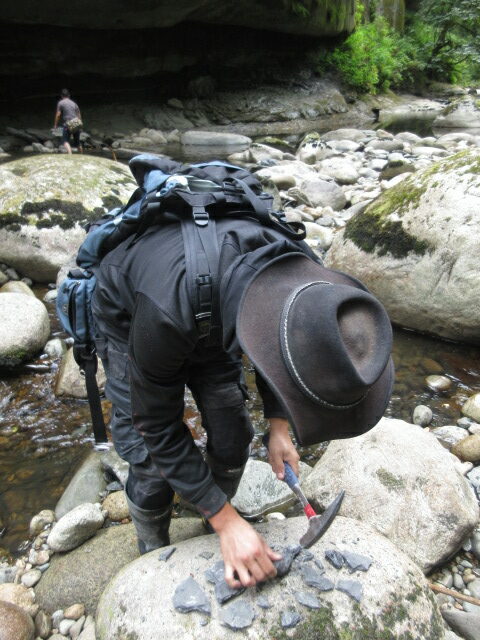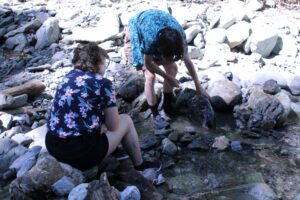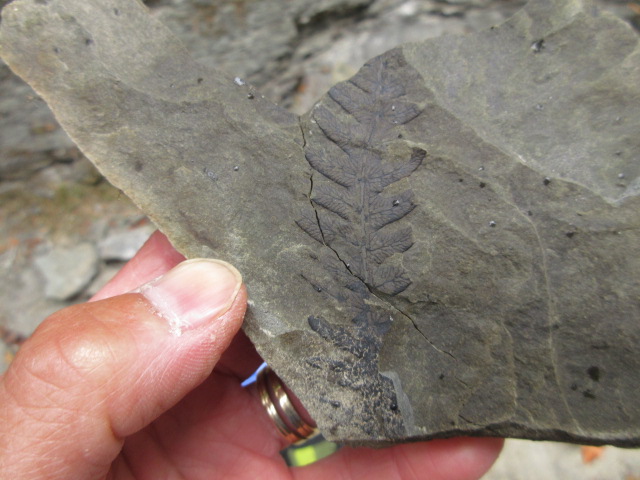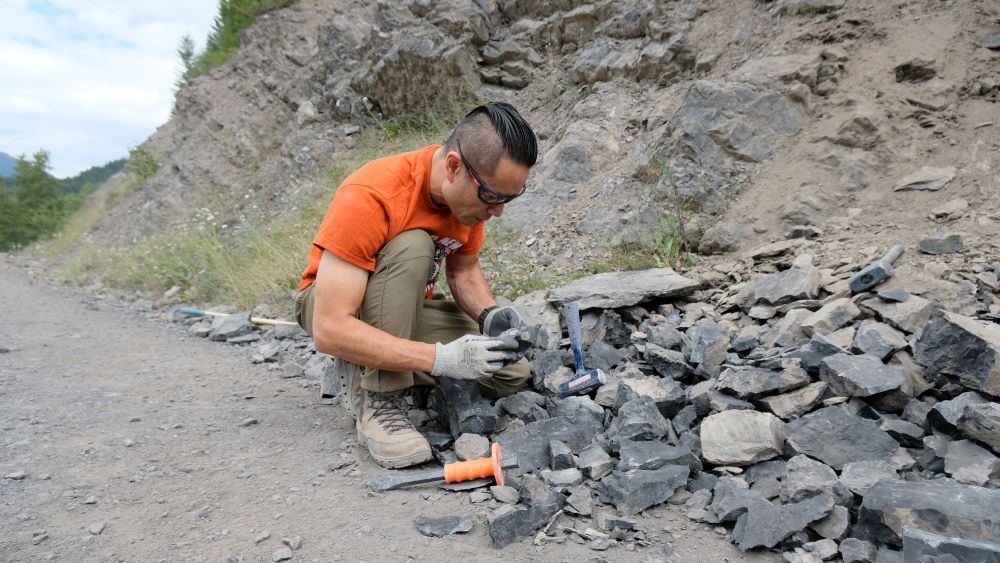VanPS Code of Ethics
Some fossils are rare, others are abundant, but all are unique and important. We recognize that the scientific information inherent in fossils is of interest to the greater community, not just those who collect them. As responsible members of the paleontological community, we strive to ensure that our fossil collections provide the maximum benefit to science and the general public. To this aim, we subscribe to the following Code of Ethics:
- Be aware of local, provincial and federal regulations concerning the collecting of fossils and determine the status of the land where you wish to collect. Ensure that appropriate permission and permits have been obtained from land owners or governmental authorities before venturing to a fossil site.
- Treat the land gently and practice good environmental etiquette. Never visit localities with inappropriately-sized groups. Ensure that all steps are taken to minimize your collecting impact on the outcrop. Clean up your own and others’ litter and close all gates that weren’t open when you arrived.
- Take appropriate safety precautions while collecting. Wear safety goggles, adequate clothing and gloves if necessary. Have a first aid kit with your group at all times.
- Ensure that all fossil collecting sites are properly documented and that all fossils collected from each locality are identified with a unique locality number. Never purposefully misrepresent the locality where a fossil was collected. Fossil collections should be maintained in a responsible manner and all information about collections and localities should be provided to interested researchers.
- Particularly important specimens should be made available for scientific description by research paleontologists – this may mean that the original specimen will be placed in a local or national museum. Fossil collections should be given to a museum or appropriate specialist or institution rather than being discarded.
- The sale, for personal profit, of fossils collected under the auspices of the Vancouver Paleontological Society is forbidden.
Members of the Vancouver Paleontological Society are urged to encourage others to inform themselves of the Code and follow its principles. Members who fail to adhere by this Code may have their membership in the organization revoked.
Please also review the British Columbia Paleontological Alliance (BCPA) policies.

What is paleontology?
Adapted from Principles of Paleobotany, by Lily Bora
Paleontology is the study of fossils. A fossil is defined as any trace of a past life form. Thus, although wood, bones, and shells are the most common fossils, under certain conditions soft tissues, tracks and trails, and even coprolites (fossil feces) may be preserved as fossils. Although most of the fossils that paleontologists study are several thousands to several billions of years old, there is no absolute minimum age for a biological structure to be a fossil.
Paleontologists study these fossils and attempt to use them to reconstruct the history of the Earth and the life on it. Some study the ecology of the past; others work on the evolution of fossil taxa.
How does paleontology differ from archaeology and anthropology?
Archaeologists primarily work with human artifacts — objects that have been made by humans — and with human remains. Anthropologists work with humans — their cultures, societies, languages, and ways of life, in addition to their bones and artifacts. Some paleontologists do study the fossil record of humans and their relatives. However, paleontology as a whole encompasses all life, from bacteria to whales. Paleontology does not usually deal with artifacts made by humans. However, archaeologists and paleontologists might work together. For instance, a paleontologist might identify fossil animal bones or plant pollen associated with an archaeological site, to find out what the people who lived there ate; or a paleontologist might be called on to analyze the climate at the time a particular archaeological site was inhabited.
What are the practical uses of paleontology?
First of all, a number of natural resources are in fact fossils, or derived from fossils. Coal, oil, and peat are derived from fossil plant material; marble is metamorphosed limestone, which is often biogenically deposited; diatomaceous earth (used as an abrasive and in gardening) is made up of fossil microscopic siliceous skeletons of certain algae. To study these resources — and to identify areas and rock layers that are likely to contain them — requires in-depth knowledge of sedimentary rocks and of the fossils contained in them. Some paleontologists work for the petroleum industry, and use fossils to interpret sequences of sedimentary rocks.
Paleontologists who work on relatively recent fossils have developed approaches to reconstructing past climates and environments. Today, environmental change, global warming, and so on are household words. Paleontologists can provide historical data on past climates and apply it towards understanding future trends and their likely effects. If we understand the effects of climate change, for instance, on our world in the past, we can understand its probable effects in the future.
Finally, paleontology is an increasingly important component of historical biology. The life around us today has been shaped through its long history, and understanding its past is important to understanding its present situation. There are a number of techniques and fields that deal with reconstructing the past, but paleontology provides hard data on past events. Paleontology can potentially provide much data on the evolutionary relationships of organisms, which in turn gives a deeper understanding of biodiversity.
How do paleontologists know how old their fossils are?

A complete answer to this question would require a book-length exhibit (we are planning an exhibit to answer this question in more detail). Briefly, paleontologists deal with two types of dating, absolute and relative. Absolute dating, which estimates the age of a rock or fossil in years, is most usually done by measuring the amounts of a radioactive isotope and its decay product; since isotope decay rates are known to be constant, the age can be calculated from the relative amounts of parent isotope to daughter product. Fossils up to about 40,000 years old can be dated using carbon-14 if there is enough organic matter present. Older rocks can be dated using potassium-40, which decays to argon-40, or uranium-235, which decays to lead-207. However, many sedimentary rocks cannot be dated directly by these methods; dates usually are obtained from igneous rocks within a sedimentary sequence, such as lava flows or ash beds. Such dates are maximum age estimates for fossils above the dated beds, or minimum estimates for fossils below the beds.
Relative dating has been practiced for nearly 200 years, arising from the observation that different layers of sedimentary rock contain different fossils, and that this sequence can be recognized in other rocks at other localities, even those far away. This allows fossil-bearing rocks to be dated relatively; on the basis of its fossils a rock might be placed in, say, the Ordovician, which came after the Cambrian and was followed by the Silurian. This technique does not depend on knowing the actual numerical ages of the rocks. Not all fossils are equally useful for relative dating, or correlation; some are rare, restricted to small geographic areas or to particular environments, difficult to recognize, or have such long ranges as to make precise correlation impossible. Fossils that are the most useful for correlation tend to be widespread, found in many rock types, easily recognizable, and short-lived enough to permit precise placement in the geologic column.
What are fossils?
Fossils are the remains of ancient life forms that lived throughout geological time. Geological processes captured and preserved them in stone. Paleontologists are scientists that act as ‘detectives,’ studying these remains to find clues to the past. The science of studying fossils is called Paleontology, just as the science of studying rocks is called Geology. Geologists also act as ‘detectives,’ studying rocks to find where there may be ore bodies that can be mined. The ‘detective processes’ both of these disciplines use are often very similar.
Fossil Animal Remains
Dinosaurs are probably the best-known fossils. That so many people know so much about them is quite amazing as they did not leave very many clues, and we really don’t know that much about them at all. Fossils of sea creatures, such as shells, and to a lesser extent, fish, are more common. We have many of these fossil sea creatures near us in the shales of Harrison Lake, and in much of the rock of Vancouver Island and the Gulf Islands. They have even found large marine reptiles in the Rockies and on Vancouver Island near Courtenay! Near Princeton and up in the Interior of BC there are Eocene lakebed and swampbed fossils of fish, birds and insects. Stromatolites, structures built by blue-green algae in warm, shallow seas, are some of the oldest fossils ever found. They represent some of the very first life forms on earth, and lived about 2 billion years ago. Examples are found near Great Slave Lake (NWT), right here in Canada.
Trace Fossils
Traces (footprints, burrows, tracks or impressions) made by living creatures can also become fossilized and give us valuable clues to they way these creatures lived. These are called Trace Fossils. We cannot always tell which animals made the trace fossils.
Fossil Plants

Leaf imprints and other fossil plant remains are fairly common in some sedimentary rocks, particularly those formed in swampy environments. In the Eocene fossil beds of BC near Princeton and Cache Creek, evergreen and broadleaf fossils have been found, along with seeds and some flowers. Plant fossils have also been found in North Vancouver, near the Capilano River, that are 65 million years old. During the Carboniferous era (around 300 million years ago), great portions of earth’s surface were covered by huge, shallow, inland seas. Plant leaf imprints are common in the sedimentary rocks that formed from the fine sediments that slowly settled out from these still waters. The leaves themselves hardly ever become fossils – they do not have enough hard parts. Fossil wood is another matter: if the cells in the original wood are filled with silica-rich solutions that crystallize to become the well-known mineral quartz, fossil wood is formed. As this kind of replacement does not disturb the structure of the original material, all the original growth rings and the cells can still be seen and studied. Coal, an economic ‘mineral’, is also fossil wood of a kind. In this case the cells have not been filled with silica, but other conditions led to the very low-grade metamorphism of the wood to become the concentrated carbon substance that we burn for fuel. Unfortunately the coal we burn is often not very pure. If other minerals, like pyrite, are also present in coal, sulfur is emitted during burning. The presence of sulfur in the atmosphere changes the pH of rainwater and we have problems related to acid rain.
How do you become a fossil?
Even though there are many fossils distributed all over the Earth, it is actually quite difficult to become a fossil – even more so when you are a land-dwelling animal or plant. A set of very special coincidences is needed for anything to become a fossil.
First, you must be buried by sediments or volcanic ash soon after death (if scavengers or floods scatter your bones, you can never become a complete fossil). Secondly, special pH conditions are required to make sure your hard parts are not dissolved. Thirdly, special solutions must circulate through the materials that bury you to replace the minerals that your skeleton is made up of with minerals that will become stone. The process is called lithification. Then, the sediments or volcanic ash that cover you have to be turned to stone (lithify) as well.
It is much easier to become a fossil if you live in the sea and simply sink to the bottom, to be covered by sediments as soon as you die. No wonder most of the known fossils are from marine environments, and that more is known about the marine creatures that lived during the time of the dinosaurs than about dinosaurs themselves!
Even if you have been lucky enough to become a fossil, the chance of your fossil remains actually being found is extremely remote. Over the millions of years it takes for someone interested in Paleontology to come along and find you, the rock you are entombed in may have be covered by thousands of meters of other sediments or volcanics (lavas) or it may have been exposed to high heat and been metamorposed into a different kind of rock – erasing the evidence of your existence or the rock may have been eroded back into sediment by wind water or ice. It is only when you are once again exposed, either by erosion, exploration drilling or mining, that you can be discovered! Just think how many layers of rocks are under the surface of the earth at present: there must be gazillions of new species of dinosaurs, ammonites, gastropods, bivalves, insects, fish, leaves and other fossils to be discovered! What we know about fossils is only the tip of the iceberg.
Are there fossils in Southwest British Columbia?
Yes! There are sedimentary rocks with fossil remains of a variety of ages in, and close to Vancouver. Around the west shore of Harrison Lake there are marine deposits of the Cretaceous and Jurassic Periods bearing a variety of remains including ammonites, belemnites and other mollusks. In the area of Princeton there are ancient lake bed sediments from the Eocene Epoch containing leaves like those of Metasequoia, insects and occasionally fish remains. There is also a rich fossil record preserved in other parts of the province. Vancouver Island is known for its Cretaceous marine fossils including some large reptiles like the Elasmosaur and Mosasaur remains discovered near Courtenay.
Why are fossils important?
Fossils are important for various reasons. For one, they give us clues to the history of life. Unraveling their lives and deaths give us clues to the environments they lived in, and how these have changed through time. This helps us understand our own fragile environment better, which gives us a better chance to survive as a species, ourselves. Extinction of species, when their environment changes, is a natural phenomenon. It has happened many, many times in the long history of our planet, Earth. At the end of the Permian (250 million years ago), for instance, 95% of the life forms known from fossil remains became extinct. That was a much bigger extinction than the famous one that saw the disappearance of most of the dinosaurs at the end of the Cretaceous (65 million years ago). The cycles of extinction of certain species and the evolution of others allow us to tell the age of rocks just by looking at which fossils we find in them. Fossils are the arms on our geological clock!
Another good reason for studying fossils is that during exploration for economic minerals, finding certain fossils can be very useful indicators of the presence of ore bodies nearby. They give us a clue to the environment at the time of the formation of the rocks they are found in. Certain economic minerals only form in specific environments. Also in the oil industry, certain species of microfossils (so small that they can only be seen under a microscope) are used as indicators as to how close the drill is to hitting oil. The copper that was mined at Britannia Beach, just north of Vancouver, formed on the ocean floor when water, heated by submarine volcanic activity, rose through fissures and vents to escape onto the seabed (a process still happening off the West Coast of Vancouver Island today). As the hot liquids circulating through these vents hit the cold seawater they dumped the mineral components they carried onto the sea floor and copper, iron and other sulfide-rich minerals precipitated to form little mounds. It is remarkable that some animals have evolved to live in these hostile environments in the cold dark depths of the oceans, next to boiling vents, where there is no oxygen! Fossils of these creatures are sometimes found in the mudstones that formed around these ore mounds, and even in the copper ore from deposits formed under these conditions. Finding ore bodies is similar to finding fossils: just like the formation and discovery of fossils, a set of very special coincidences need to take place. The Exploration Geologist also needs to know where to look and this usually involves some geological detective work.
How to collect fossils
Essential equipment:

- Rock hammer: Use a geology or masonry hammer from a rock shop or hardware store. The head of regular wooden handled hammers can work free of the shaft quite quickly.
- Safety goggles: Hammering rock produces chips of razor-sharp flakes that fly at high speeds right at your face and eyes!
- Gloves: The first time you swing at a rock you are holding in one hand and miss you will be thankful you wore them.
- Chisel: Use cold chisels that are made for rock work – do not use wood chisels, the metal is too soft.
Other equipment:
- Steel-toed boots: You WILL drop a large, heavy rock on your foot at some point.
- Dental picks: Ask your dentist if there are any old dental picks that he or she will be throwing out. They can not be resharpened, so they are regularly discarded.
- Newspaper, paper towels, masking tape, felt-tip pens, White-Out and zip-lock bags: When two fossils rub together they damage one another. By wrapping them individually in newspaper or paper towels you prevent this damage. Tape the wrapped fossil shut and write a locale note on the tape with your waterproof pen. Zip-lock bags are great because you can keep the pieces of a fossil that has broken together – also, you can toss a note on identification and locality right in with the fossil.
Labeling:
Later, at home, you will want to label your fossils. An unlabeled fossil is just a pretty rock! Possibly a very pretty rock, but a mere rock nonetheless. To be valuable to science you must assign a unique catalogue number to each specimen. The point of cataloging fossils is to be able to determine, at a later date, exactly where and when a fossil was collected.
Decide upon a numbering system – any system is fine as long as it is clear and you use it consistently. You may want to use your initials as a prefix and then a four digit number. For example, if your name is James Osterberg, you may wish to number your specimens JO-0001, JO-0002, etc. Some people prefer to have a site prefix, such as CH-1-001, CH-1-002 for “Chuckanut formation, Site 1, Specimen #1, Chuckanut formation, Site 1, Specimen #2, etc.” Princeton fossils may be P-1-001 for the Whipshaw Creek site, and P-2-001, etc. for another Princeton area site. Ask about a system and establish one for yourself right away!
To label the fossils, daub a little White-Out on a non-important part of the fossil and then take your waterproof (regular non-waterproof ink will smear with handling) fine tip felt pen and put your number on the White-Out spot. Some people put a layer of clear fingernail polish over this.
Sources for supplies and equipment
Deakin
1361 Powell Street, Vancouver, BC V5L 1G8
Tel: 604-253-2685
Toll-free 1.800-663-3735 (in N.A.)
Website: https://www.deakin.com/
Good selection of hammers, chisels, safety glasses and outdoor wear.
Mountain Gems
4611 Hastings Street, Burnaby, BC V5C 2K6
Tel: 604-298-5883
Toll Free: 1-888-593-1888
Website: www.mountaingems.com
Some hammers, chisels and safety glasses. Primarily lapidary supplies.
